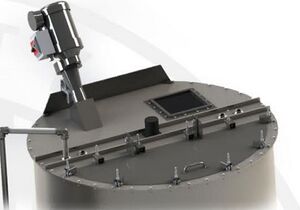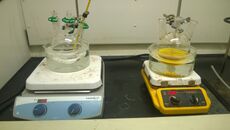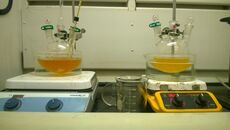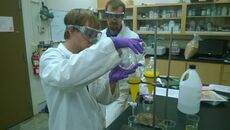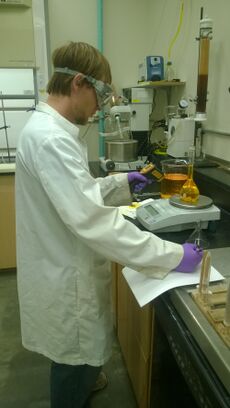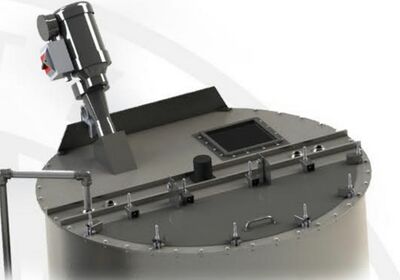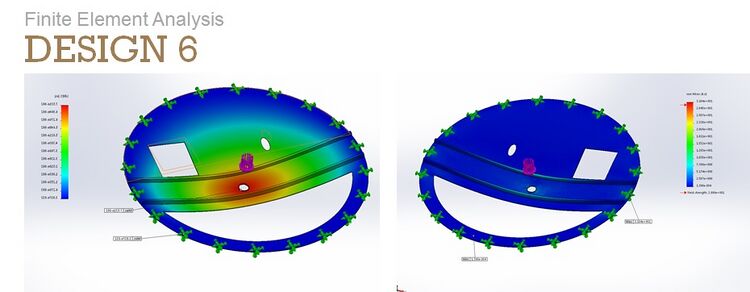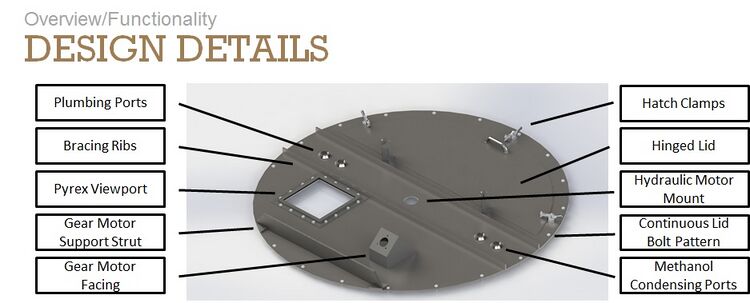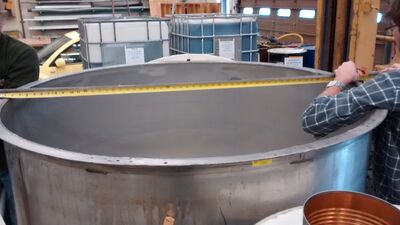Biodiesel Research Reactor
| Biodiesel Reactor Lid | |
| Sponsors | |
| Team Name | Liquid Gold |
| Duration | Fall 2014-Spring 2015 |
| Faculty Advisers | |
| Mentor |
|
| Students |
|
The Department of Biological and Agricultural Engineering at the University of Idaho operates a pilot-scale biodiesel reactor to research issues with biodiesel production and provide fuel to the biodiesel fleet of the University. Team Liquid Gold is undertaking to design a lid and ingredient containment system in order to reduce the hazards currently associated with the process. It is hoped that our project will allow future automation of biodiesel manufacturing at the University, and eventually incorporate methods of improving reaction time and biodiesel conversion rate.
Problem Definition
Background
"The objective of this team will be to design and fabricate a state of the art pilot scale biodiesel reactor to address challenges for industrial partners. This system will handle reagents such as methanol and liquid sodium methlyate."
Deliverables
- Design an enclosed reactor system for safe operation of base transesterification
- Size and design a condenser to capture and reflux alcohol back into the system
- Design a system for thorough Agitation of reaction vessel.
- Design a system for temperature control of the reaction
Taken from the formative problem statement issued at the beginning of the semester.
Project Learning
To gain an initial understanding of the processes our client currently used, we arranged for a benchtop scale production session. We had the opportunity to work hands-on on making a small (<1 gallon) batch of biodiesel, to understand the procedures and risks involved. Photos below show moments from the benchtop session, while the flowchart at bottom right represents the current system as operated by BAE personnel.
Further research during fall semester included testing of the different agitation systems available for the reactor, and observation of a full-scale manufacturing attempt with the biodiesel reactor.
In order to finalize our understanding of what equipment would be suitable or unsuitable for this research reactor, we divided into multiple sub-teams to research the options available for the different needs of the reactor. Based on our conclusions, we prepared a summary presentation for our client, to confirm our intended concept design components.
Presentation of Conceptual Options for System Needs
System Specifications
Based on our preview meeting with the client, we designated five systems within the reactor design to address our attention to.
System 1: Ingredient Introduction and Mixing
- Contain all ingredients needed for biodiesel manufacture
- Minimize user contact with ingredients
- Allow direct feed of ingredients into reaction system
- Allow user control of ingredient quantities to meet desired recipes
- Incorporate agitation systems for thorough ingredient mixing
System 2: Enclosed, Explosion Proof Reactor
- Seal off reaction and prevent escape of vapors
- Include viewing ports for observers and connections for connected systems
- Provide easy access to interior of reactor for setup, cleaning, or maintenance
- Provide breakaway/controlled failure in case of explosion
- Incorporate sonification tool for reaction improvement
System 3: Methanol Recapture
- Capture vaporized methanol from the open space in the reactor
- Condense methanol vapor back to liquid methanol
- Return liquid methanol to reactor
- Maintain reactor vessel pressure at atmospheric pressure
System 4: Instrumentation
- Fully automate system and allow push-button operation
- Incorporate sensors to acquire reaction data
- Utilize Programmable Logic Control to automate ingredient metering
- Utilize Programmable Logic Control to maintain reactor temperature and agitation autonomously
System 5: Heating
- Heat the oil to the desired operating temperature within an hour
- Maintain reactor temperature at a specified set point
- Allow autonomous heating control by interfacing with System 4 Instrumentation
- Meet safety needs for explosion and fire avoidance
Project Revisions
Updated Problem Statements
Due to budget constraints, we were unable to proceed with the comprehensive system design plan as specified above. After discussion with the project client, the scope of the project was redefined to focus on enclosing the reaction with a detailed lid design. Accordingly, the project goals and specifications were revised as follows:
The goals of the final project are:
• Provide a stainless lid for the reactor
• Incorporate a hinged access hatch
• Provide viewports, mixer mounts, and fixtures for plumbing
• Include enclosure venting and methanol condensing
• Control potential explosion paths
The specifications of the final project are:
• No materials used will react with the chemical process
• The design shall be cleanable without disassembly
• The design shall prevent methanol escape from the enclosure
• The design shall channel explosion hazards away from areas of use
• The design shall provide an illumination source to the tank interior
Detail Design Review On February 26, 2015, Team Liquid Gold conducted a detail design review with faculty and staff from the Department of Biological and Agricultural Engineering acting as clients for the project. We presented our design for the lid, which was approved by the clients for completion. The summary of the proceedings is attached at the end of the wikipage.
Current Design
Lid Model
FEA Analysis
A Finite Element Analysis was performed on the structural members of our lid design. The results are as follows:
- Displacement: 0.0753”
- Stress: 31.04 (ksi)
Lid Specifications
Construction Progress
Tank Rounding
One of the major obstacles we had to overcome to make our design work was the reactor tank's deviation from a perfectly round shape. The initial state of the vessel was described by diameters varying between 55.25" and 54.375", or nearly an inch of difference between the widest and narrowest points of the vessel.
It was our initial plan to try to measure the deviation of the shape, in order to create a tank lid model with a profile that matched the vessel's deformations. This would allow us to put the lid on the reactor and have the two profiles match so that the lid neither overhung nor underhung the lip of the reactor flange.
This would have been a difficult and tedious task, however. At the suggestion of Jack McHargue, we attempted using bar clamps to apply pressure to the wider portions of the vessel, in order to push them back in and cause the narrower portions to press back out.
Our attempts were successful. By repeated minor compressions of the tank walls, we were able to reduce the widest diameter to 55" even, and the narrowest diameter to 54 13/16". In other words, the difference between widest and narrowest diameters was reduced from 7/8" to less than 3/16". Having proved that this concept worked, we were able to proceed with specifying an ordering a perfectly round tank lid, with the plan to repeat any tank reshaping procedures as needed during final assembly.
Water Jet Cutting
Large sheet metal cutting is being provided pro bono by Bay Shore Systems of Rathdrum, ID.
Welding
Welding is being contracted through the University of Idaho Facilities Services.
Final Assembly
Due to time and team training constraints, Final Assembly is being continued through the summer of 2015 by the Department of Biological and Agricultural Engineering
Future State
The future state proposed for the biodiesel reactor lays out the following improvements to be implemented during future design projects:
- Automated batch metering with solenoid valves and level sensor controls
- Inline resistive oil heating
- Recirculating sonication to expedite transesterification
- All stainless ingredient tanks and systems
- Fully progammable HMI (Human Machine Interface) to allow remote operation of reactor
Team Information
Document Archives
Target Specifications and Needs for Reactor Design
System Concepts for Biodiesel Reactor
Detail Design Review Presentation
Biodiesel Project Poster displayed at Engineering EXPO
Concluding Instructions for Biodiesel Project Completion
Final Report by Team Liquid Gold on Reactor Upgrade Project
